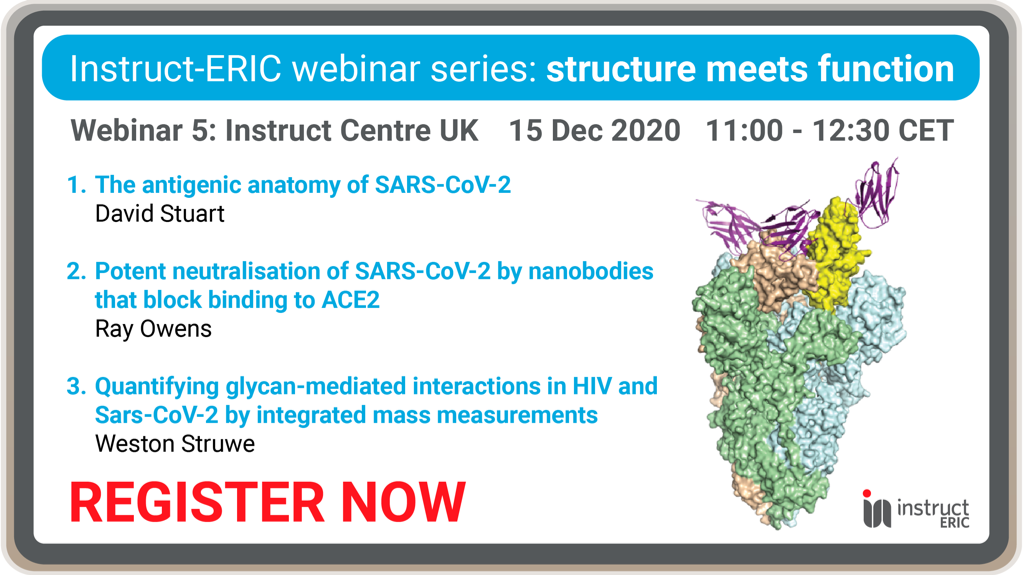 Instruct
Instruct

Featuring expert speakers from Instruct Centres across Europe, Instruct-ERIC Webinar Series: Structure Meets Function highlights some of the latest developments in structural biology, demonstrating how integrative methods are enabling scientists to decipher the mechanisms that underpin health and disease.
Watch the previous webinars in the series here.
The fifth webinar in the series will be hosted by Instruct Centre UK on 15 December 2020, 11:00 - 12:30 CET.
Webinar moderator: Rebecca Thompson
The Astbury Centre for Structural Molecular Biology
Talk 1: The antigenic anatomy of SARS-COV-2
Speaker: David Stuart
Abstract: Although it is less than a year since it was identified, SARS-COV-2 is now one of the better understood viruses. Like other structural biologists we have established collaborations to try to understand B-cell responses to the virus using a variety of methods. I will outline some aspects of the work which has led to a detailed map of how about ~80 antibodies attach, and reflect on possible implications of the results.
Talk 2: Potent neutralisation of SARS-CoV-2 by nanobodies that block binding to ACE2
Speaker: Ray Owens
Abstract: We have identified multiple single domain antibodies (nanobodies) that potently neutralise live SARS-CoV-2 virus in vitro. Using a naive llama single-domain antibody library and PCR-based affinity maturation, we rapidly produced a first generation series of closely related nanobodies, that block the interaction between the receptor binding domain (RBD) of the virus spike protein and ACE2. Single-particle cryo-EM revealed that the nanobodies bind to all three RBDs in the spike trimer. Crystal structures of each nanobody–RBD complex in combination with biophysical analyses has shown how sequence changes through affinity maturation have led to an increase in binding. We have now produced a second generation series of nanobodies by immunisation with significantly increased affinity and the potential to be developed into therapeutics for the treatment of Covid19.
Talk 3: Quantifying glycan-mediated interactions in HIV and Sars-Cov-2 by integrated mass measurements
Speaker: Weston Struwe
Abstract: Enveloped viruses express a number of spike glycoproteins on their surface that interact with its cognate host in two ways 1) receptor binding and cell fusion and 2) recognition by the immune system, namely B-cells that produce neutralizing antibodies. A comprehensive understanding of these interactions is critical for developing drugs aimed to block cell fusion as well as the rationale design of vaccines that elicit a protective antibody response. Glycosylation has an important role in both regards, especially among vaccines where poor molecular mimicry of the virus can weaken vaccine efficacy. Furthermore, the macromolecular assembly of spike glycoproteins results in the presence of multiple receptor and antibody binding sites, making interaction or structural studies challenging. Here, using single-molecule mass photometry, we show how the SARS-CoV-2 spike (S) glycoprotein interacts with the ACE2 receptor (angiotensin-converting enzyme 2) and uncover that ACE2 stoichiometry has a notable effect in extensive S crosslinking. Combining mass spectrometry with mass photometry, we uncover the interplay between protein architecture and site-specific glycosylation on the HIV envelope spike (Env) and its cooperative effect on broadly neutralizing antibody binding. Taken together, these studies demonstrate the unique ability of mass photometry to observe and quantify interactions that are effectively intractable by conventional structural or biophysical methods.